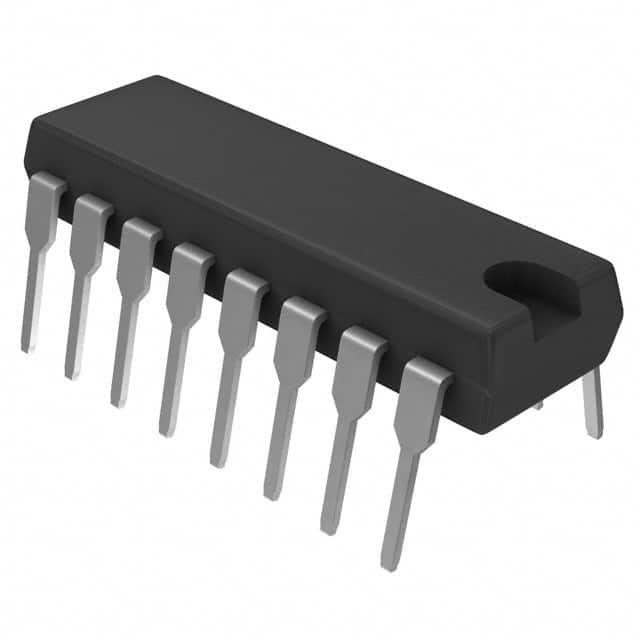CD4049UBE
Product Overview
- Category: Integrated Circuit (IC)
- Use: Logic Inverter/Buffer
- Characteristics: Hex Inverting Buffer/Converter, High Sink Current Capability, Wide Operating Voltage Range
- Package: DIP (Dual Inline Package)
- Essence: The CD4049UBE is a member of the CMOS 4000 series of integrated circuits. It consists of six inverting buffer gates, each with a single input and output.
- Packaging/Quantity: Available in tubes or reels, with 25 pieces per tube/reel.
Specifications
- Supply Voltage: 3V to 18V
- Input Voltage: 0V to VDD
- Output Voltage: 0V to VDD
- Operating Temperature: -55°C to +125°C
- Propagation Delay: 60ns (typical)
Detailed Pin Configuration
The CD4049UBE has a total of 16 pins, numbered as follows:
- Pin 1: Input A (Gate 1)
- Pin 2: Output A (Gate 1)
- Pin 3: Input B (Gate 2)
- Pin 4: Output B (Gate 2)
- Pin 5: Input C (Gate 3)
- Pin 6: Output C (Gate 3)
- Pin 7: VDD (Positive Power Supply)
- Pin 8: Ground
- Pin 9: Output D (Gate 4)
- Pin 10: Input D (Gate 4)
- Pin 11: Output E (Gate 5)
- Pin 12: Input E (Gate 5)
- Pin 13: Output F (Gate 6)
- Pin 14: Input F (Gate 6)
- Pin 15: Not Connected
- Pin 16: VSS (Negative Power Supply)
Functional Features
- Hex Inverting Buffer/Converter: The CD4049UBE consists of six independent inverting buffer gates, allowing for signal inversion or level shifting.
- High Sink Current Capability: The IC can sink up to 12mA of current, making it suitable for driving various loads.
- Wide Operating Voltage Range: The CD4049UBE can operate within a wide voltage range, from 3V to 18V.
Advantages and Disadvantages
Advantages
- Low power consumption due to CMOS technology.
- High noise immunity.
- Wide operating voltage range allows for compatibility with different systems.
- Compact DIP package for easy integration into circuit designs.
Disadvantages
- Limited output current capability compared to some other ICs.
- Propagation delay may affect timing-sensitive applications.
Working Principles
The CD4049UBE is based on CMOS (Complementary Metal-Oxide-Semiconductor) technology. It utilizes a combination of P-channel and N-channel MOSFETs to achieve its logic functions. When an input signal is applied, the corresponding buffer gate inverts the signal and provides the inverted output.
Detailed Application Field Plans
The CD4049UBE finds applications in various fields, including:
- Logic level shifting: It can be used to convert logic signals between different voltage levels.
- Signal inversion: The IC can invert digital signals, which is useful in certain communication protocols.
- Oscillator circuits: By utilizing the inverting buffers, the CD4049UBE can be employed in oscillator circuits to generate square wave signals.
- Sensor interfacing: It can interface sensors with different voltage requirements to microcontrollers or other digital devices.
Detailed and Complete Alternative Models
Some alternative models to the CD4049UBE include:
- CD4069UB: Similar to the CD4049UBE, but with non-inverting buffer gates.
- CD4050B: Hex Non-Inverting Buffer/Converter IC.
- CD40106B: Hex Schmitt Trigger IC.
These alternative models offer similar functionality and can be used as replacements depending on specific requirements.
Word count: 532 words
10个与CD4049UBE在技术解决方案中的应用相关的常见问题及解答
Sure! Here are 10 common questions and answers related to the application of CD4049UBE in technical solutions:
Question: What is CD4049UBE?
Answer: CD4049UBE is a hex inverter/buffer IC (integrated circuit) that can be used for signal amplification, level shifting, and logic inversion.Question: What is the voltage supply range for CD4049UBE?
Answer: The voltage supply range for CD4049UBE is typically between 3V and 18V.Question: Can CD4049UBE be used as a voltage level shifter?
Answer: Yes, CD4049UBE can be used as a voltage level shifter to convert signals from one voltage level to another.Question: How many inverters are there in CD4049UBE?
Answer: CD4049UBE has six independent inverters, making it suitable for various applications requiring multiple inverters.Question: What is the maximum output current of CD4049UBE?
Answer: The maximum output current of CD4049UBE is typically around 6mA.Question: Can CD4049UBE be used for driving LEDs?
Answer: Yes, CD4049UBE can be used to drive LEDs by connecting the LED to the output pin through a current-limiting resistor.Question: Is CD4049UBE compatible with TTL (Transistor-Transistor Logic) inputs?
Answer: Yes, CD4049UBE is compatible with TTL inputs, making it suitable for interfacing with other TTL devices.Question: Can CD4049UBE be used for audio applications?
Answer: Yes, CD4049UBE can be used for simple audio applications such as audio signal amplification or waveform generation.Question: What is the typical propagation delay of CD4049UBE?
Answer: The typical propagation delay of CD4049UBE is around 60ns.Question: Can CD4049UBE be used in battery-powered applications?
Answer: Yes, CD4049UBE can be used in battery-powered applications as it operates within a wide voltage supply range and has low power consumption.
Please note that these answers are general and may vary depending on specific application requirements and datasheet specifications.


